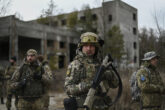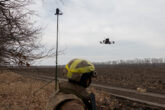February 18, 2022
US, Russia Should Establish Deconfliction Line for Air Operations Over the Black Sea – Now
The Russian threat to invade Ukraine is upending the correlation of forces in Europe, with US and NATO members deploying forces and hardware to bolster the Eastern flank in response to Russia’s military build up. While all eyes are on Ukraine, there are secondary challenges that could emerge in other parts of Europe and may increase the risk of accidental escalation.
The airspace over the Black Sea is one area where dangerous interactions could further heighten tensions, as American and Russian air forces may come into close contact in the skies as the crisis unfolds. The good news is that both Washington and Moscow have an interest in managing these interactions and installing guard rails for air operations in congested environments.
There’s even a model to follow: the two nations should harness lessons learned from air operations in Syria and establish deconfliction mechanisms to ensure that actions over the Black Sea don’t spiral out of control.
The similarities are clear: like Syria, the Black Sea would represent a crowded air space prone to air-to-air interactions with Russian fighters, along with an intact surface-to-air missile threat. Unprecedented numbers of Russian, US, and NATO naval vessels with organic air assets are currently operating in the Mediterranean and Black Sea. Further afield, in the Eastern Mediterranean, Russia has demonstrated it is willing to act aggressively in the skies against US assets, even during this period of heightened tension.
Russia has not yet invaded Ukraine, so a policy of engagement costs the West little, and the potential for a breakthrough incentivizes continued engagement with Moscow. Given the scope of expected American and European sanctions, and the political costs of being seen as appeasing Moscow, once an invasion begins it would be almost impossible to work on such a concept. Given this negative trajectory, it is imperative to find mechanisms for communications now to manage risk and increase transparency.
Read the full article from Breaking Defense.
More from CNAS
-
Defense / Transatlantic Security
When Defense Becomes Destruction: Austria-Hungary’s Mistake and Ukraine’s RiskThis article was originally posted on War on the Rocks. The southeastern Polish city of Przemyśl, with its elegant 19th century Habsburg-era train station, remains one of the ...
By Franz-Stefan Gady
-
Defense / Transatlantic Security
Ukraine’s Catch-22 MomentThis article was originally published in the Financial Times. In Joseph Heller’s wartime classic, Catch-22, the protagonist Yossarian seeks out the US army surgeon Doc Daneeka...
By Franz-Stefan Gady
-
CNAS Insights | Budgetary Own Goals Undermine “Speed and Volume”
On November 7, Secretary of Defense Pete Hegseth laid out a plan to overhaul the Department of Defense’s (DOD’s) acquisition system. Placing an emphasis on delivering new capa...
By Philip Sheers, Carlton Haelig & Stacie Pettyjohn
-
Drones: Who Is Making the New Weapons of War?
From Ukraine and Russia to Gaza and Sudan, drones have become a key weapon of war. Which companies are making them, and profiting from this rapidly expanding but controversial...
By Stacie Pettyjohn




